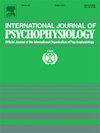“自我兴奋”——自恋特征预示着在谈话中自我表露时生理唤起的升高。
IF 2.6
3区 心理学
Q3 NEUROSCIENCES
引用次数: 0
摘要
个体的自我表露动机和生理反应各不相同。然而,目前尚不清楚一个人的自我认知是否会导致这种差异。本文探讨了自我表露对高、低水平浮夸自恋者自主神经系统活动的影响。为了模拟不同情境下的自我表露,我们进行了三个会话实验:相识(实验1)、谈论情感生活经历(实验2)和讲述不同自我关联的情感故事(实验3)。这些实验是在同一组22对(n = 44)的样本上进行的。实验1并没有证实高度浮夸型自恋者(N+)的交感神经兴奋增强的预期,而实验2关注于讲述积极和消极的生活经历,支持了N+个体皮肤电导增加的假设。实验3采用了更具体的主题,这些主题在自我相关方面有所不同,进一步支持了自恋与自我表露过程中生理唤醒的升高有关的观点。值得注意的是,当被别人欣赏时,N+个体的皮肤电导特别高。探索性分析表明,当出纳员(无论是N+还是N-)与N+的共同参与者讨论时,他们的皮肤电导更加明显。本文章由计算机程序翻译,如有差异,请以英文原文为准。
‘Wired up about self’ - narcissistic traits predict elevated physiological arousal during self-disclosure in conversation
Individuals vary in their self-disclosure motivations and physiological responses. It is unclear, however, whether the content of a person's self-view accounts for this variation. In this paper we explore the impact of self-disclosure on autonomic nervous system activity in participants with high and low levels of grandiose narcissistic traits. Three conversational experiments were conducted to simulate different contexts of self-disclosure: getting acquainted (Experiment 1), talking about emotional life experiences (Experiment 2), and telling emotional stories with varying self-relevance (Experiment 3). The experiments were conducted on the same sample of 22 dyads (n = 44) measured in a single session. While Experiment 1 did not confirm the anticipated heightened sympathetic arousal in participants with high grandiose narcissism (N+), Experiment 2, focusing on telling about positive and negative life experiences, supported the hypothesis of increased skin conductance among the N+ individuals. Experiment 3, with more specific topics that varied in self-relevance, further supported the notion that narcissism is associated with elevated physiological arousal during self-disclosure. Notably, the skin conductance of the N+ individuals was particularly heightened when telling about being admired by others. Exploratory analyses showed that tellers' (whether N+ or N-) skin conductance was even more pronounced when they were discussing with an N+ co-participant.
求助全文
通过发布文献求助,成功后即可免费获取论文全文。
去求助
来源期刊
CiteScore
5.40
自引率
10.00%
发文量
177
审稿时长
3-8 weeks
期刊介绍:
The International Journal of Psychophysiology is the official journal of the International Organization of Psychophysiology, and provides a respected forum for the publication of high quality original contributions on all aspects of psychophysiology. The journal is interdisciplinary and aims to integrate the neurosciences and behavioral sciences. Empirical, theoretical, and review articles are encouraged in the following areas:
• Cerebral psychophysiology: including functional brain mapping and neuroimaging with Event-Related Potentials (ERPs), Positron Emission Tomography (PET), Functional Magnetic Resonance Imaging (fMRI) and Electroencephalographic studies.
• Autonomic functions: including bilateral electrodermal activity, pupillometry and blood volume changes.
• Cardiovascular Psychophysiology:including studies of blood pressure, cardiac functioning and respiration.
• Somatic psychophysiology: including muscle activity, eye movements and eye blinks.

 求助内容:
求助内容: 应助结果提醒方式:
应助结果提醒方式:


